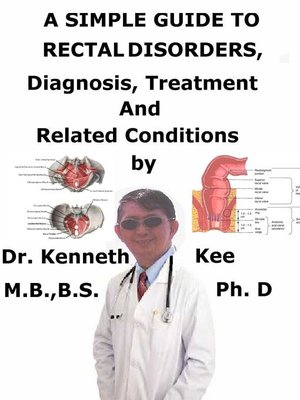A Simple Guide to Rectal Disorders, Diagnosis, Treatment and Related Conditions
ebook
By Kenneth Kee

Sign up to save your library
With an OverDrive account, you can save your favorite libraries for at-a-glance information about availability. Find out more about OverDrive accounts.
Find this title in Libby, the library reading app by OverDrive.



Search for a digital library with this title
Title found at these libraries:
| Library Name | Distance |
|---|---|
| Loading... |
This book describes Rectal Disorders, Diagnosis and Treatment and Related Diseases
"The Rectal examination"
"Take it easy, Doc.
You are boldly going where no man has gone before"
The rectum is the last four or five inches of the intestinal tract.
The rectum consists the lower component of the large intestine where the body stores stool.
The rectal outlet or opening is termed the anal canal or anus.
Disorders in the rectum are frequent but adults are too embarrassed to ask their doctor about them.
They are hemorrhoids, abscesses, incontinence and cancer.
Fortunately, most of these disorders can be treated when recognized early and properly diagnosed.
Any symptoms of rectal pain or bleeding should always be thoroughly evaluated by the doctor.
The most frequent causes of Rectal Disorders are:
1. Constipation (hemorrhoids)
2. Chronic diarrhea (rectovaginal fistula)
3. Hereditary factors (cystic fibrosis, Hirschsprung disease, spina bifida)
4. Excessive sweating in the area around the anus (proctitis)
5. Aging (rectal prolapse)
Less frequent or secondary causes of rectal disorder (discomfort, pressure) may be:
1. Cancer (rectal cancer);
2. Infection, including anorectal abscesses (proctitis, rectal inflammation) prostate problems (prostatitis) may produce pressure, pain, or throbbing sensations in the rectum;
3. Inflammatory bowel diseases, such as ulcerative colitis and Crohn's disease;
4. Foreign bodies in the rectum or rectal prolapse; and
5. Tailbone pain (coccydynia or pain around the coccyx)
Risk Factors for Rectal Disorders
These factors may raise the likelihood of Rectal Disorders:
1. High daily salt intake
2. History of diabetes
3. Hyperlipidemia
4. Dermatosis
5. Anorectal surgery
6. History of smoking and alcohol intake
7. Sedentary lifestyle
8. Excessive intake of spicy food
9. Prolonged sitting on the toilet for defecation
These symptoms are indicative of Rectal Disorders:
1. Pain in the perianal area
2. Constipation
3. Drainage from the rectum
4. Fever
5. Palpable mass near the anus
6. Burning sensation
7. Pus discharge
8. Blood
9. Diarrhea
10. Swelling in around the rectum and anus
For most people, the diagnosis of the cause of rectal disorder is made a doctor by taking the patient's history and performing a physical exam that includes a rectal exam.
A digital rectal exam is required to make the diagnosis of levator ani syndrome.
During the exam, the doctor can palpate the levator ani muscles.
The muscles may be tight and tender, and palpating them can reproduce the pain.
Other methods are:
Lower gastrointestinal tract radiography: To detect disease and abnormalities and diagnose symptoms and to avoid more invasive procedures
Lower gastrointestinal series: To view the large intestine
Colonoscopy: To view the entire colon and rectum
The treatment of rectal disorders is dependent on its underlying cause.
An urgent evaluation in the emergency department might be required if these symptoms develop:
1. Rectal pain becomes more severe, especially if linked with fevers and infectious discharge from rectum.
2. Pain is no longer confined to the rectum but spreads to the abdomen.
3. There is an increasing amount of rectal bleeding
4. The patient suspects a foreign body in the rectum or rectal prolapse as the cause of pain.
The self-care actions or lifestyle changes may help in the treatment:
1. Avoid constipation
2. Increase water...







